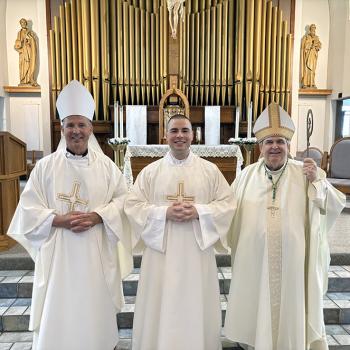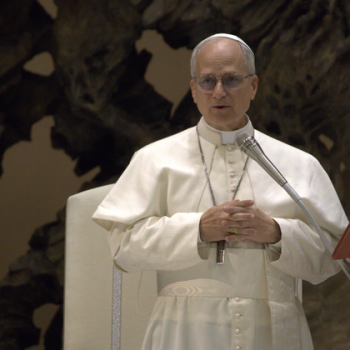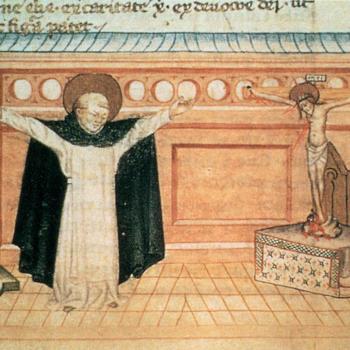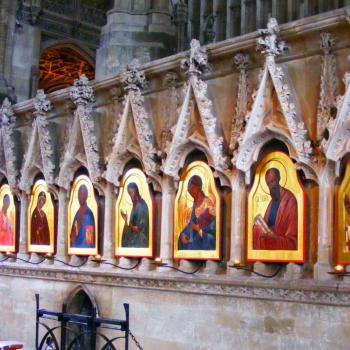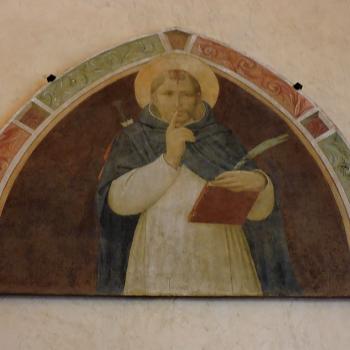The church is the body of Christ, where are find ourselves united with Christ, becoming one with him in and through grace. Through it we find that the Logos is not going to external to us, but comes into the world to become one with us. Indeed, he not only comes inside us, but we become inside him, as we join together with him and become a part of his body. This union must not be seen to be absorption where we lose our personal character, but rather, it is a means by which we find ourselves fully ourselves, no longer separated from the Logos through the veil of the ego. We freely unite ourselves with Christ, and in Christ, all others who have joined with him to become a part of his body, through self-giving love which is open to and receives love in return. We become truly a christ in Christ, not identical to the person of the Logos, but nonetheless, one with him where the dualistic division between him and us vanishes. Only after we see Christ in others, reach out and die to the self in love with Christ in others, will we our communion, with its potential grace, be fully realized as it makes us one with Christ and work with him in the world as well as experience in and with Christ the blessing of the Divine life found in the Trinity.
![San Damiano cross [Public domain], via Wikimedia Commons](https://wp-media.patheos.com/blogs/sites/637/2017/02/Kruis_san_damiano-216x300.gif)
On that day the trumpet will be blowing from the four corners of this middle earth, and then all will arise – whomever the earth swallowed and fire burned up and sea drowned and wild animals ate and birds bore away – all of them will arise on that day. On that day our Lord will sit on his [throne? –HK], the great majesty. And his face and his body will appear. Then the wounds will be seen by all the sinful, yet by the faithful he will be seen whole. [4]
Likewise, even when in his historical form, the Logos as Logos was able to be encountered, that is, the Logos could be seen in and through his divine activity and so encountering him was not limited to merely his historical manifestation. Those who knew him as the Eternal Word, those who saw who Christ truly was while encountering him in and through his humanity, were able to see him in a way which transcended those who persecuted and rejected Christ. Both saw him in history, but only those who opened themselves up to his grace so as to be perfected by him were truly able to see him for who he was beyond his historical form. That is, they were able to see the Logos, the Word of God, while those who rejected him with hate saw him only as a man and knew him only as a man. This is why Pilate, though he saw Jesus before him, only saw him as a man causing problems, while his Apostles were able to see the Word made flesh, as Origen explained:
The apostles themselves saw the Word, not because they had beheld the body of our Lord and Savior, but because that had seen the Word. If seeing Jesus’ body meant seeing God’s Word, then Pilate, who condemned Jesus, saw God’s Word; so did Judas the traitor and all those who cried out, “Crucify him, crucify him, remove such a one from the earth.” But far be it that any unbeliever should see God’s Word. Seeing God’s Word means what the Savior says: “He who has seen me has also seen the Father who sent me.”[5]
A human point of view of the Logos tends to limit him either to his historical form, or worse, seeing him not as someone from history but merely of legend, rejecting his existence in history itself. Even those who deny his history encounter him in legend and so see him and reflect upon him in and through human wisdom, covering from themselves the reality of who he is by their abstraction. We must eliminate from ourselves all such human wisdom, the veil which hides Christ from us. Then we can encounter him in his glorified body, or with grace, in his universal body of the church which finds ourselves no longer divided from him but with him so we one with Christ, and our history becomes a part of the history of Christ on earth. If we deconstruct our human wisdom, and let it vanish, we open ourselves to his presence without obstruction, and then at last, we can be like Paul, and say: “From now on, therefore, we regard no one from a human point of view; even though we once regarded Christ from a human point of view, we regard him thus no longer” (2Cor. 5:16 RSV).
Therefore, if we first encounter Christ in his historical form (or sub-historical form, if it is believed he did not exist in history but is merely a figure of legend), we should not hold ourselves to seeing him only in that form. But how can we do that? Only if we listen to what he said and did in and through that form. For what he told us to do, that is, to come follow him, pick up our cross and die to the self, will be the way in which we find ourselves being transformed by him and encountering him in ways beyond his historical form. We will slowly see him in his greater forms the more we reveal the image and likeness of God, the image of love, in us, an image which is revealed through our own self-emptying which imitates the self-emptying of the Logos in his incarnation. Then, through the grace which comes to us, we can find ourselves being purified of sin and encountering the Logos in his glory, that is, in his transfigured form, giving us great joy and happiness in his presence, only to then take that form and find ourselves uniting with him, no longer separate from him but one with him, participating with him in the divine reality where God shall be all in all. This is how our spiritual life should progress, where we start out in history and encounter Christ in history, and end deified through our full and uninterrupted union with Christ.
[1] Origen, “On First Principles” in ANF(4):239.
[2] On the other hand, with the right view, with a mind purified from the veil of sin, the divine activity of Jesus Christ is able to be seen so that not only is the Logos, but also the Father and Spirit able to be discerned through the historical Christ.
[3] The Gospels show him walking through walls, appearing and disappearing at will, even having a bodily form which is truly his and yet is unrecognized by his disciples until he wills the recognition to be made.
[4] Vercelli Homily II, “The Day of Judgment” in Anglo-Saxon Spiritualty. Selected Writings. trans. Robert Boenig (New York: Paulist Press,2000), 88. I have added what I believe was a word missing in the text (and without checking the original, to know if it was missing in the original or in the translation).
[5] Origen, Homilies on Luke. trans. Joseph T. Leinhard, SJ (Washington, DC: Catholic University of America Press, 1996). 7-8.
Stay in touch! Like A Little Bit of Nothing on Facebook:
A Little Bit of Nothing






